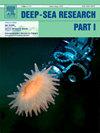The roles of benthic diversity and environmental factors in nutrient and macrofaunal dynamics within the oxygen minimum zone of the British Columbia continental slope
IF 2.3
3区 地球科学
Q2 OCEANOGRAPHY
Deep-Sea Research Part I-Oceanographic Research Papers
Pub Date : 2025-05-22
DOI:10.1016/j.dsr.2025.104530
引用次数: 0
Abstract
Global warming has expanded oxygen minimum zones (OMZs), or oceanic “dead zones”. Despite their ecological significance, the diversity, and functional roles of benthic organisms in nutrient cycling and carbon (C) uptake in OMZ remain understudied. In this study, we focused on the Northeast Pacific continental slope OMZ (600–1200 m depth) off Vancouver Island, Canada, along an oxygen and depth transect (∼77, 40, and 10 μmol ‧ l−1 at 200-, 475-, 850-m depth, respectively). Using a multicorer we collected sediment cores and performed shipboard incubations to examine organic matter remineralization and nutrient flux rates. In parallel, we performed pulse-chase tracer incubations with isotopically labeled algae (Phaeodactylum sp.) at the 475- and 850-m sites, to assess macrofaunal C uptake and benthic nutrient flux responses to fresh phytodetritus. Our results revealed no clear influence of decreasing oxygen on macrofaunal abundances, nutrient regeneration, or on the role of infauna in organic matter remineralization. Nontheless, organic matter quantity and quality strongly influenced macrofaunal community structure. Despite differences in community composition among sites, we also observed no clear relationship between macrofaunal community composition and nutrient fluxes, with phytoplankton-based food as a key food source for oxygen-deficient-adapted infauna. The highest C uptake rate and highest net nutrient influxes at the 475 m site contrasted lower rates at 850 m site, where only one flabelligerid and one cirratulid polychaete species ingested the organic matter, followed by amphipods, cumaceans, unidentified crustaceans, and bivalves, all primarily in the upper 2 cm of sediment. Our findings highlight the complex interplay of oxygen, depth, and organic matter, suggesting that organic matter quality and quantity may obscure oxygen effects on benthic biodiversity and ecological processes.
不列颠哥伦比亚省陆坡最低氧带底栖生物多样性和环境因子在营养和大型动物动态中的作用
全球变暖扩大了氧气最小带(OMZs),即海洋“死亡区”。尽管底栖生物具有重要的生态意义,但其多样性及其在OMZ养分循环和碳(C)吸收中的功能作用仍未得到充分研究。在这项研究中,我们重点研究了加拿大温哥华岛附近东北太平洋大陆坡OMZ (600-1200 m深度),沿着氧气和深度样带(分别在200-,475-,850-m深度为~ 77,40和10 μmol·l−1)。我们使用多层覆盖物收集沉积物岩心,并在船上进行孵育,以检查有机物再矿化和营养通量率。与此同时,我们在475米和850米的地点用同位素标记的藻类(Phaeodactylum sp.)进行了脉冲追踪示踪培养,以评估大型动物对C的吸收和底栖生物对新鲜植物碎屑的营养通量的反应。我们的研究结果显示,氧气减少对大型动物丰度、养分再生或动物在有机物再矿化中的作用没有明显的影响。然而,有机质的数量和质量对大型动物群落结构有强烈的影响。尽管不同地点的群落组成存在差异,但我们也观察到大型动物群落组成与营养通量之间没有明确的关系,以浮游植物为基础的食物是缺氧适应动物的主要食物来源。475 m位置的碳吸收率和净营养物流通量最高,而850 m位置的吸收率较低,只有一种软肋类和一种环状多毛类摄入有机物,其次是片脚类、cumac纲、未识别的甲壳类和双壳类,所有这些都主要在沉积物的上部2 cm。我们的研究结果强调了氧气、深度和有机质之间复杂的相互作用,表明有机质的质量和数量可能掩盖了氧气对底栖生物多样性和生态过程的影响。
本文章由计算机程序翻译,如有差异,请以英文原文为准。
求助全文
约1分钟内获得全文
求助全文
来源期刊
CiteScore
4.60
自引率
4.20%
发文量
144
审稿时长
18.3 weeks
期刊介绍:
Deep-Sea Research Part I: Oceanographic Research Papers is devoted to the publication of the results of original scientific research, including theoretical work of evident oceanographic applicability; and the solution of instrumental or methodological problems with evidence of successful use. The journal is distinguished by its interdisciplinary nature and its breadth, covering the geological, physical, chemical and biological aspects of the ocean and its boundaries with the sea floor and the atmosphere. In addition to regular "Research Papers" and "Instruments and Methods" papers, briefer communications may be published as "Notes". Supplemental matter, such as extensive data tables or graphs and multimedia content, may be published as electronic appendices.

 求助内容:
求助内容: 应助结果提醒方式:
应助结果提醒方式:


